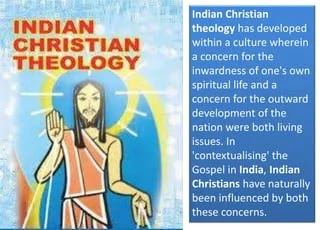Christology in Indian Traditional Approach
Jesus as Fulfiller
J.N. Farquhar
(1861-1929) theology
was based on the fulfillment Theory. Hinduism has gleams of light in it and a
Hindu is right in following it until the higher light reaches them. In Hinduism
there is an aspiration which would be considered as preparation for Christ, and
every important Christian truth is part of Hinduism. He uses the fulfillment
idea in evolutionary sense and sees the process of fulfillment as a radical
displacement of Hinduism by Christianity. He utilized the fulfillment theory to
Hinduism and presented his interpretation regarding the relationship between
Christianity and Hinduism.
Farquhar
argues that Christianity or rather Christ is the crown of Hinduism. He painted
this notion creatively in his book ‘The crown of Hinduism’. Christ
provides the fulfillment of each highest aspiration and aims of Hinduism. Every
true motive which is in Hinduism has found expression in unclean, debasing, or
unworthy practices finds in Him fullest exercise in work for the downtrodden,
the ignorant, the sick, and the sinful. In Him is focused every ray of light
that shines in Hinduism. Christ is breathing life into the Hindu people. Unlike
other missionaries he never rejected Hinduism as evil but he considered it in
line with fulfillment. The Christianity that he talks of is not Christianity as
it is practiced by Christians but Christianity as it springs from Christ
himself. In fact, he passes for Christ to Christianity and back as if they were
identical
Christ as Prajapati
This
notion was proposed by Krishna Mohan Banerjee. He discusses the
self-sacrifice of Prajapati, as the key to the understanding of the
meaning of sacrifice. Krishna Mohan opines that the biblical doctrine of
salvation by the sacrifice of Christ finds a remarkable counterpart in the
Vedic understanding of salvation by the self-sacrifice of Prajapati. According
to KM Banerjee the meaning of Prajapati coincides with the meaning of the name
and office of the historical reality of Jesus Christ. The name Prajapati not
only means “the Lord of the creatures” but also supporter, feeder and deliverer
of his creatures. The name ‘Jesus’ in Hebrew means the same ‘the name of
Prajapati’, therefore, singularly corresponds to the name of Jesus”. Then he
shows how Jesus and Jesus alone, fulfils what Prajapati stood for in the
primitive Vedic tradition and that Jesus is the true Prajapati; and the
Christian Church – the true Ark of salvation.
Christ
is the true Prajapati – the true Purusha begotten in the beginning before all
worlds, and Himself both God and Man. The doctrines of saving sacrifice, the
primary religious rites of the Rig Veda – of the double character Priest and
victim, variously called Prajapati, Purusha and Viswakarma.







